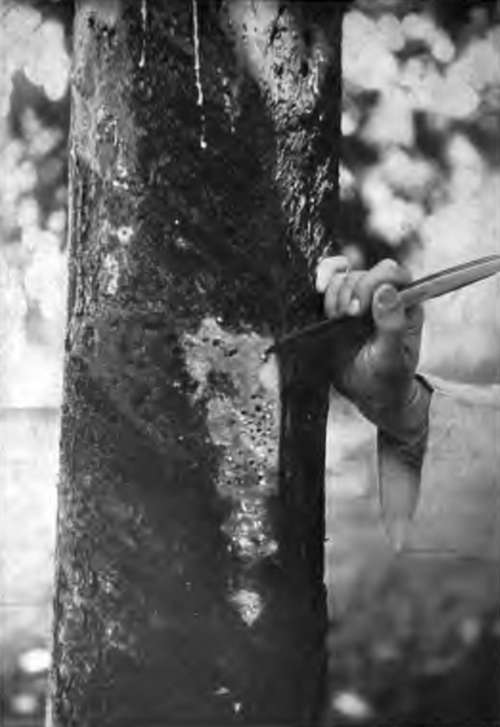Burrs And Nodules
Description
This section is from the book "Rubber And Rubber Planting", by R. H. Lock. Also available from Amazon: Rubber And Rubber Planting.
Burrs And Nodules
A common complaint affecting the stems of Hevea trees, to which no sufficient cause has yet been assigned, consists in the development of woody nodules in the bark. These sometimes make their appearance upon a large number of trees at particular periods in a manner highly suggestive of an epidemic, and grow so rapidly as to interfere seriously with the operation of tapping. Hitherto it has not been found possible to show that the nodules are associated with any specific organism attacking the bark; nor are they constantly associated with mechanical injury, although there is evidence to show that they appear in greater numbers on trees which have been tapped with a pricking instrument than on trees which have only been pared. In fact, the whole subject of their origin seems to require further investigation.
Plate X

Nodules in Hevea Bark
The nodules arise as minute woody bodies buried in the growing bark, quite independently of the proper wood of the tree. Their presence is first betrayed by a swelling and cracking of the outer bark. If the surface of such a swelling is sliced off with a sharp knife, numerous nodules, about the size of small peas, are found embedded in the bark. At this stage they may be carefully extracted with the point of a knife, and if this extraction is carried out with thoroughness the bark recovers and no further injury is done. If neglected, however, the nodules grow with great rapidity, and fuse with one another and with the actual wood of the tree. The surface of the tree now shows extensive rugged prominences over which tapping by the ordinary process of paring is no longer possible. The woody mass may still be prized off with a hatchet or a crow-bar, but a ragged and extensive wound is left which takes a long time to heal.
At certain seasons these nodules have appeared on large numbers of trees all over Ceylon. At other times their appearance may pass almost unrecorded for years together. It was observed that the worst visitation occurred after a prolonged period of drought, and was most severe at high elevations and on trees which had been severely tapped, especially where the pricker had been employed. The appearance of the nodules is therefore apparently facilitated by anything which tends to weaken the vitality of the trees.
The outbreak in question occurred in the spring of 1911, At this time a marked difference in the severity of the epidemic was observed on two similar plots of Hevea trees at Peradeniya, each one acre in extent On plot A upwards of 60 per cent, of the trees were affected, and on plot B only about 10 per cent. Plot A had received during the two preceding years applications of a concentrated mixture containing 150 lbs. of sulphate of ammonia, 100 lbs. concentrated superphosphate and 100 lbs. sulphate of potash. Plot B was unmanured. During the twelve months immediately preceding the outbreak, plot A had been tapped by paring and pricking with the spur-shaped pricker, whilst the trees on plot B were pared only on a similar system. It seems natural to associate the larger proportion of nodular outgrowths on plot A rather with the pricking than with the manuring, but it is apparent that the whole subject requires further study.
Continue to:
- prev: Die-Back
- Table of Contents
- next: General Sanitation
